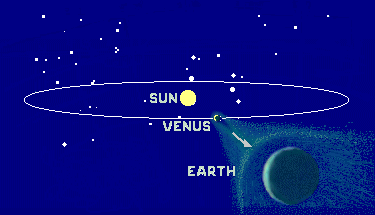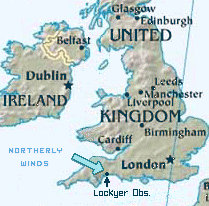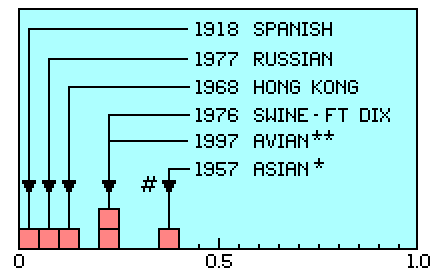
584 Day Synodic Period
(The column location for the 1918 pandemic was corrected on
08 Sep 2007.)
The # sign marks the end of the six month interval between the 1918
Earth-Venus conjunction and the beginning of the 1918 pandemic deadly phase.
* Some scholars think the 1957 Asian flu started in Vladivostok in
1956.
**The bird-to-human phase of the 1997 Hong Kong flu started in March 1997.
Testing the Venus Influenza Hypothesis
From http://www.shadetreephysics.com/1918rd.htm.
Three of the four influenza pandemics in the twentieth century had onsets
that followed Venus inferior conjunctions by 30 to 60 days. (Barber found
that geomagnetic storms seemed to be a co-factor, in addition to the
conjunctions, when the Lockyer bacterial events occurred.)
"The Non-Prediction Prediction"
3 April 2001
At 1015 Universal Time (UT) on 29 March 2001 the sun produced an intense
X-class Coronal Mass Ejection (CME) which gobbled up a lesser CME from
the day before and reached Earth at 0100 UT on 31 March. At approximately
0400 UT 30 March (on the day in-between) Venus passed through inferior
conjunction.
It wouldn't, of course, be prudent to make predictions about what this
combination of events might lead to, some 30 to 60 days from March
30. On the other hand, if really out-of-the-ordinary viral (not
necessarily "influenza") and/or bacterial outbreaks do occur in
pockets around the globe during that time frame, then we might opt
to examine the Venus connection hypothesis more closely.
*The not necessarily influenza phrase was added (as a long shot)
because the author had come across news information about other diseases,
including legionnaires disease, breaking out shortly (within one to two
months) following Venus inferior conjunctions.
Influenza Related News in the Northern Hemisphere
April thru July 2001
The majority of the information in this section, (and in two other sections
below) is anecdotal in nature, but it is hoped that readers can discern an
underlying pattern.
References to the on-line resource LEXIS-NEXIS®Academic Universe
are indicated by the abbreviation LNAU.
Friday 13 April 2001
Personal observation by author - Columbus Mississippi area - U.S.A..
For about two weeks, starting on April 13, 2001 many of the author's
co-workers and members of their families (toddlers through adults)
experienced rapidly spreading illnesses characterized by intense stomach
cramps, diarrhea and vomiting, accompanied by extreme exhaustion.
[These symptoms might be considered as evidence of some "not necessarily
influenza" maladies suggested in the non-prediction prediction above,
but they started two and a half weeks before 1 May.]
Saturday 14 April 2001
Financial Times Information - Global News Wire
Karachi, Pakistan
Influenza from a new form of flu virus is spreading in the Pakistan
seaport city of Karachi. Throat ailments and tonsils infections noted in
particular.
(LNAU - Medical. - Search Term: flu)
The following graph, which is based on CDC published data, shows the two most
pronounced May 5, 2001 (week 18) regional activity "bumps" in influenza related
activity in the United States.
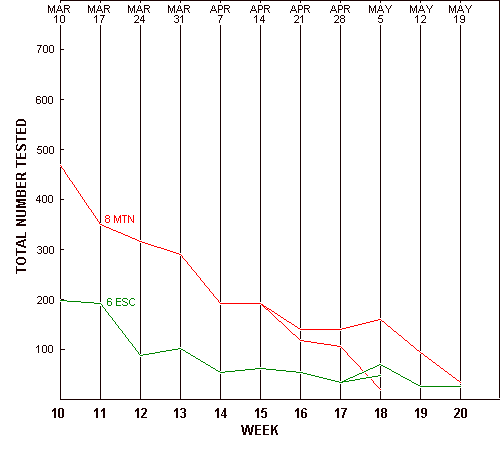
Total Number of Isolates Tested vs Week
(The lower branches on the profiles are based on week 18 data.)
MTN = Mountain; ESC=East South Central.
5 May 2001 was 36 days following the 29 March 2001 Venus inferior conjunction. Whether or not
the bumps are related to new forms of influenza is yet to be determined.
Sunday 6 May 2001
The Edmonton Sun
Calgary, Alberta - Canada
Mystery illness spreads from school children to family members. 179 students and
staff at Elizabeth Barrett elementary school in Calgary became suddenly sick on
Wednesday 2 May with vomiting, nausea and diarrhea. Lightning-fast
stomach flu was believed to be blame. City water system ruled out as source. The
diarrhea generally lasts 24 hours.
(LNAU - World News - Search Term: influenza - 29 May 2002.)
10 - 13 May 2001
Kazakhstan
Information received via personal e-mail on 16 May.
On May 10-13th the television of Alma-Ata reported that an epidemic of an
unidentified influenza has passed [through the region]. The illness
starts with a cough, a high temperature runs and dyspnea [difficult or labored
breathing] develops. The illness is treated badly by conventional drugs. ...
Children are sick more often [than adults].
Friday 11 May 2001
St. John's Telegram
North Battleford, Saskatchewan, Canada
Community struggles to cope with cryptosporidium parasites that have crippled 52
residents and 74 visitors with cramps and diarrhea and have shut down
businesses. Most residents thought they had been having a bout with the flu. Outbreak
occurred just before Easter, which was April 15th. Questions as to how water supply
became contaminated and why it took so long to have the problem identified are
widespread.
(LNAU - World News - Search Term: influenza. - 29 May 2002)
Thursday 17 May 2001
China
Isolation of influenza A(H5N1) virus in poultry in Hong Kong Special Administrative
Region of China - "No human cases of H5N1 virus have
been detected. The strains isolated from the birds differ genetically from the H5N1 virus
which caused human disease in 1997." (They killed all the chickens!)
Source: World Health Organization - Communicable Disease Surveillance and Response
(CSR).
Thursday 17 May 2001
Extracts from
The Pacific Dust Express
https://science.nasa.gov/science-news/science-at-nasa/2001/ast17may_1
"North America has been sprinkled with a dash of Asia! A dust cloud from China
crossed the Pacific Ocean recently and rained Asian dust from Alaska to Florida."
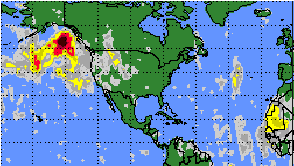
"Above: While much of the dust cloud remains over the Pacific Ocean, the leading edge
has reached as far east as the American Midwest by April 13. Images such as this one
are a principal tool for scientists who study aerosols." [The NASA image has been
"resized" and cropped.]
[April 13 was the date that the rash of flu-like gastro-intestinal problems began
occurring at Columbus, Mississippi in the U.S.A. With that in mind, note the apparent
aerosol "blob" over north Mississippi. If that blob turns out to have been part of the asian
dust, then the plot thickens!]
Wednesday 23 May 2001
Financial Times Information - Global News Wire
Indonesia
A Jakarta Indonesia writer describes the plight of "a lot of people" that are being infected
by cold and flu viruses. The viruses seem to circulate from person to person and back again.
"They won't go away."
(LNAU - Medical. - Search Term: flu)
Top
27 May 2001
In response to an inquiry by this writer, Jay Herman, Principal Investigator for the NASA
system that was used to track the Asian dust cloud mentioned above, stated "We have
found bacteria and molds on dust coming across the Atlantic from Africa, but no such studies
have been done on the Asian dust." The African dust study, by NASA and USGS, was
published in the September 2001 issue of Aerobiologia(6).
Friday 8 June 2001
Kosovo
Communicable Disease Surveillance and Response Report
Acute haemorrhagic fever syndrome in Kosovo
[Haemorrhagic fever is similar to the final stages of the 1918 influenza.]
The WHO Office in Kosovo has reported 27 cases and 4 deaths between 18 May and
7 June 2001 in the south-western area. . . .
[Note]
[Haemorrhagic fever was a real problem in Bosnia and Herzegovina between December
1994 and May 1995. That outbreak began one to two months following the 5 November
1994 Venus inferior conjunction.]
Friday 22 June 2001
Financial Times Information - Global News Wire
Pakistan
Flu Spreads in Karachi
A flu virus is still making the rounds in Pakistan seaport city.
(LNAU - Medical: Search Term: Flu)
Wednesday 4 July 2001
Arizona, U.S.A.
A visitor to the website from Jerome, Arizona (about 50 miles southwest of Flagstaff) wrote:
(Many people in the local area) have been suffering from recurrent bouts with some
kind of flu for around six weeks now. It is characterized by abdominal cramps,
diarrhea, headaches, weakness and lightheadedness. [Six weeks ago would have
been around 23 may.]
Global Influenza 2001-2002
A(H1N2)
From
http://www.shadetreephysics.com/vel/1918h1n2.htm
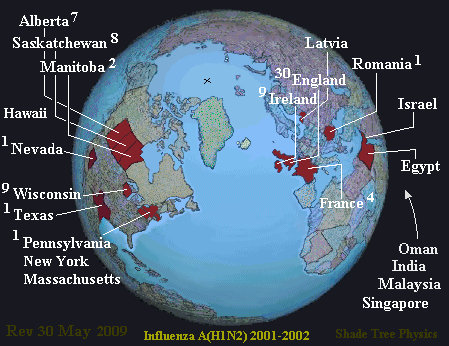
The globe above shows (in red) states and countries where the new influenza strain
A(H1N2) has been identified (isolated) during the 2001-2002 influenza season.
(Where known, the numbers of cases are shown in superscript.) As of 30 August 2002,
the season total for A(H1N2) in Canada was 72.
The first acknowledged case of H1N2 in the United States occurred in Texas in July 2001,
followed by another case in Nevada in September. (See the 14 February 2002 entry below.)
Selected Influenza A(H1N2) Related News Items
18 January 2002 - England
Outbreak of flu-like illness in a Cornwall comprehensive school -
About half the students are suffering respiratory symptoms but initial tests
for influenza are negative. Further tests are underway. A second outbreak
has occurred in a school in Scotland.
[At the time of this report Influenza A(H1N2) was not on the books.]
Source: Public Health Laboratory Service (PHLS) - Infectious Diseases in the News.
http://www.phls.co.uk/news/bulletins/2002/020118id.htm [No longer available on www.}
6 February 2002 - England.
WHO announces the isolation of a new strain of influenza virus- A(H1N2), . . .
"The new strain has been so far been isolated from humans in England, Israel, and
Egypt in the last few weeks. A similar event is reported to have occurred in
China in the 1988/1989 influenza season when a number of influenza isolates
were detected which were determined to have arisen as a result of reassortment.
Further spread of these reassortment viruses in humans did not occur at that time." -
Source: Public Health Laboratory Service (PHLS) - Infectious Diseases in the News.
http://www.phls.co.uk/news/bulletins/2002/020206id.htm [No longer available on www.]
7 February 2002 - United States - Wisconsin.
Unusual Influenza Strain Identified in Wisconsin -
A six month old child in Outagamie county became ill in December 2001 and has made
a complete recovery. No additional cases have been detected. "The evolution of this
virus, which has been named A/Wisconsin/12/2001(H1N2), appears to have resulted
from the combination or "reassortment" of the genes of the currently circulating A/New
Caledonia(H1N1) and the A/Moscow(H3N2) strains of influenza A."
Source: Wisconsin Department of Health & Family Services - Reference Center - 07
February 2002.
14 February 2002 - United States.
"On February 6, 2002, WHO and the Public Health Laboratory Service (PHLS) in the
United Kingdom reported the recent identification of a new influenza virus strain,
influenza A(H1N2), isolated from humans in England, Israel, and Egypt. In addition
to the viruses reported by PHLS, the Centers for Disease Control and Prevention (CDC)
has identified influenza A(H1N2) viruses from patient specimens collected during July,
September, and December 2001 in Texas, Nevada, and Wisconsin, respectively."
Source: CDC - National Center for Infectious Diseases - Influenza Summary Update -
Week ending February 9, 2002-Week 6.
https://www.cdc.gov/flu/weekly/weeklyarchives2001-2002/weekly06.htm
8 March 2002 - Global.
Influenza A(H1N2) viruses (update) "Between September 2001 and February 2002
reassortant influenza A(H1N2) viruses have been isolated from outbreaks or sporadic
cases in Canada, Egypt, France, India, Israel, Latvia, Malaysia, Oman, Singapore, the
United Kingdom and the United States."
Source: Weekly Epidemiological Record - 2002, 77, 77-80 - World Health Organization -
PDF
http://www.who.int/wer/2002/en/wer7710.pdf?ua=1
2 May 2002 - Wisconsin USA
Influenza A(H1N2) Viruses in Wisconsin - The initial Wisconsin isolate was recovered
from a specimen collected December 7, 2001 from a six month old child [in Outagamie
county]. Eight additional A(H1N2) isolates were detected between January 11 and
February 11, 2002 from patients aged 9 through 31 years. Seven of these came
from St. Vincent Hospital in Green Bay [Brown county]. All of the Wisconsin H1N2
isolates to date have been from [the] two adjacent counties. [Names of counties added.]
Source: Wisconsin State Laboratory of Hygiene, Madison, WI.
http://www.virology.org/Newsletter/May02/May0205.html
- [Link needs updating - 11 Jan 2018.]
Was the Influenza A(H1N2) of 2001-2002
Derived from Terrestrial Reassortment?
From http://www.shadetreephysics.com/vel/1918h1n2.htm
Most, if not all, of the summaries about the new influenza strain, A(H1N2),
state that it has arisen as a result of reassortment. In this case it means
that a victim gets attacked by two different strains of influenza A, which mix and
match parts to produce a new strain. For the new strain A(H1N2) the requisite
originals are said to have been A(H1N1) and A(H3N2). (There is usually the
unstated implication that the process took place in Earth's biosphere .)
The following graphs show the relative abundances of influenza strains during the
2000-2001 and 2001-2002 flu seasons.
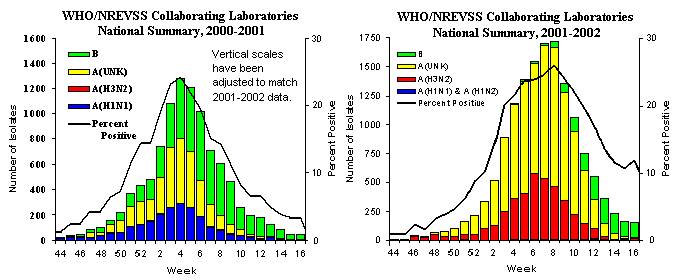
It can be seen that in the 2000-2001 flu season there was a relative abundance of A(H1N1)
(blue bars) but very little A(H3N2) (red bars). In 2001-2002 the situation was reversed.
On 30 August 2002 the Canada National Microbiology Laboratory published its
2001-2002 seasonal summary for influenza. They reported antigenically characterizing
the following influenza subtypes: 333 A(H3N2); 72 (H1N2) (the new strain); and one
case of A(H1N1).
On 22 May 2001 the U.S. National Center for Infectious Diseases published its final report
for the United States 2001-2002 flu season. They reported the following influenza A
sub-types: 3,996 H3 viruses and 83 H1 viruses. What these numbers don't tell, is that at
the time the first H1N2 case in Wisconsin was detected (on 7 December 2001) there had
been approximately 175 H3N2 cases detected antigenically throughout the United States but
only one H1N1 case, and that case had occurred five weeks earlier at an
undisclosed location. From 11 January to 11 February, when the remaining eight Wisconsin
H1N2 cases were detected, there were approximately 2251 H3N2 cases detected
nationwide, but only 15 of the H1N1 strain. NCID has not published
where these cases occurred or how many of them (if any) were in Wisconsin.
Top
Asian Influenza B Leaves Home
This phenomenon was overlooked by this investigator during the 2001-2002 flu season.
The attitude was, "Who cares about influenza B?"
24 April 2002 - WorldWide
Influenza B viruses currently circulating worldwide can be divided into two antigenically
distinct lineages: B/Yamagata/16/88 and B/Victoria/2/87. B/Yamagata viruses have
circulated widely since 1990, and the B component of the current influenza vaccine
belongs to this lineage. Since 1991, B/Victoria viruses have not been identified outside
of Asia. However, since March 2001, B/Victoria lineage viruses have been identified in
many countries, including the United States. Of the 96 U.S. influenza B viruses
characterized antigenically this season, 53 were of the B/Yamagata lineage, and 43 were
of the B/Victoria lineage.
Source: CDC MMWR 2002;51:276-279 (Reprinted in the Journal of the American Medical
Association
http://jama.ama-assn.org/issues/v287n16/fpdf/jwr0424.pdf -
JAMA April 24, 2002 -- Volume 287, No. 16, page 2068. [page not found]
http://jamanetwork.com/journals/jama/issue/287/16
[Haven't found the report yet. 15 Jan 2017]
Results, Discussion, and Recommendations
The 13 April 2001 arrival of the Asian dust storm in the mid-west of the United States
and the coincident onset of gastrointestinal flu-like symptoms in northeast Mississippi
may be related. (Data from other areas visited by the dust cloud are needed to beef up the
picture.)
It is speculated that the early April Pacific Dust Express delivered the B/Victoria
viruses to U.S. doorsteps. The dust, albeit greatly thinned out, traveled on to Europe as well.
The mid-may 2001 outbreak of a new strain of avian influenza in Hong Kong and the
unidentified influenza that swept through in Alma-Ata, Kazakhstan, fell right in the
middle of the non-prediction prediction window.
No report, seen to date by this investigator, has suggested a migration from one geographical region to another of the new influenza A(H1N2) strain. Its distribution pattern seems to have been a global non-spreading sporadic affair.
The sporadic global nature and the timing of the outbreaks of the influenza A(H1N2)
strain are considered to be consistent with the idea of an extraterrestrial source. (Timing, as used here, includes a month (or less) to penetrate Earth's atmosphere
plus a two-month-or-so recuperation period, inside 98.6°F surface dwellers, to
repair space radiation damage incurred en route.)
There is apparently no clinical evidence from Canada or the United States of
terrestrial (Earth's surface) reassortment of influenza A(H1N1) and A(H3N2) to
produce A(H1N2).
Real world conditions matched the non-prediction prediction very well. That doesn't
prove that the new flu strains were from an extraterrestrial source, but it does
strengthen the idea that there may be something to the hypothesis. Further study is warranted.
The World Health Organization (WHO), through the offices of their Global Agenda on Influenza, and appropriate space agencies may need to join forces to examine possible connections between wide area aerosol movements and the arrivals of airborne pathogens
If no convincing clinical evidence comes to be found for terrestrial reassortment,
which produced the new influenza A(H1N2) strain, and if no compelling geographical spreading pattern is established for the new strains, then epidemiologists should
think about "getting outside the box."
With a possible outer space connection in mind, the WHO should perhaps think about
setting up a space-borne monitoring capability to obtain previews of what's coming
our way.
* * *
The full study is available online at
http://www.shadetreephysics.com/vel/1918.htm
References
(1) Gina Kolata,
Flu, The Story of the Great Influenza Pandemic of 1918
and the Search for the Virus That Caused It,
Simon & Schuster, Touchstone, New York, (1999).
(2) Velikovsky, Immanuel,
Worlds in Collision, The Macmillan Company (1950),
Double Day (1950).
(3) Fred Hoyle and Chandra Wickramasinghe,
Diseases from Space, J.M. Dent
& Sons, London, 1979.
(4) Jayant Narlikar, Chandra Wickramasinghe, et al., Dramatic new evidence
of living bacteria coming from space. Presented at the Astrobiology session
of the 46th Annual SPIE meeting in San Diego, CA, July 29, 2001. See an
online summary at http://www.cf.ac.uk/news/releases/0107/010729.html
(5) Donald Barber, Perspective, Focal Press,
London, Vol. 5, pp. 201-208,
(1963). For a recent thumbnail sketch of Barber's report, see the online
article: Living Micro-Organisms From Space : Real or Apparent? - Norman
Lockyer Observatory News 01/1997.
http://www.ex.ac.uk/nlo/news/nlonews/1997-01/9701-14.htm - [Link no longer works.]
(6) Dale W. Griffin, Virginia H. Garrison, Jay R. Herman and Eugene A. Shinn,
African desert dust in the Caribbean atmosphere: Microbiology and public health,
Aerobiologia, 17:203-213 (2001).
End of document
|
